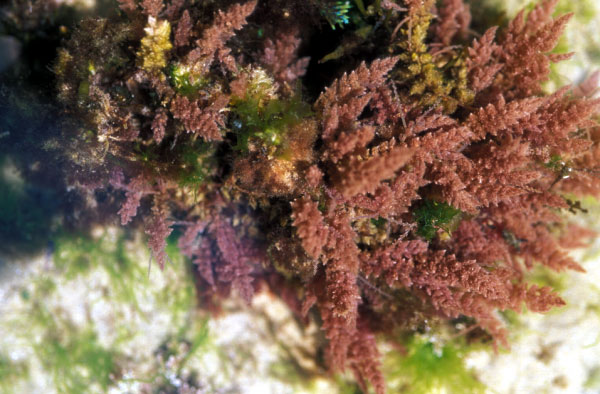Falkenbergia rufolanosa Harvey
Pale purplish-red, quickly degenerating when removed from the water and becoming distinctly orange; fronds bushy, with a cylindrical axis to1 mm wide and 200 mm long. Both phases readily reproduce vegetatively. Photographs by M.D. Guiry

Biorefinery of the green seaweed Ulva lactuca to produce animal feed, chemicals and biofuels
The growing world population demands an in- crease in animal protein production. Seaweed may be a valu- able source of protein for animal feed. However, a biorefinery approach aimed at cascading valorisation of both protein and non-protein seaweed constituents is required to realise an eco- nomically feasible value chain. In this study, such a biorefinery approach is presented for the green seaweed Ulva lactuca containing 225 g protein (N × 4.6) kg−1 dry mat- ter (DM). The sugars in the biomass were solubilised by hot water treatment followed by enzymatic hydrolysis and centri- fugation resulting in a sugar-rich hydrolysate (38.8 g L−1 sugars) containing glucose, rhamnose and xylose, and a protein-enriched (343 g kg−1 in DM) extracted fraction. This extracted fraction was characterised for use in animal feed, as compared to U. lactuca biomass. Based on the content of essential amino acids and the in vitro N (85 %) and organic matter (90 %) digestibility, the extracted fraction seems a promising protein source in diets for monogastric animals with improved characteristics as compared to the intact U. lactuca. The gas production test indicated a moderate rumen fermentation of U. lactuca and the extracted frac- tion, about similar to that of alfalfa. Reduction of the high content of minerals and trace elements may be required to allow a high inclusion level of U. lactuca products in animal diets. The hydrolysate was used suc- cessfully for the production of acetone, butanol, ethanol and 1,2-propanediol by clostridial fermentation, and the rhamnose fermentation pattern was studied.


